#king tiridates
Photo

Khor Virap
Khor Virap is a monastery located in Armenia that was first established in 642 CE. Its name is derived from "virap nerk'in," which means "deep dungeon" in Armenian. Khor Virap is one of the most sacred and visited sites in Armenia primarily due to the legend of Saint Gregory the Illuminator who was imprisoned for 13 years in Khor Virap's dungeon before succeeding in the conversion of King Tiridates (Trdat) the Great to Christianity in the first decades of the 4th century CE. During the Middle Ages, Khor Virap was a center of education and learning, and despite a colossal earthquake in 1679 CE, it remains a site of pilgrimage and immense cultural interest to Armenians today.
Learn more about Khor Virap
46 notes
·
View notes
Note
well i am asking about your nero pdfs
there are many books & nero biographies that give a general analysis of nero's character and/or his principate and are easy to find + access (i always recommend edward champlin and myriam griffin), but aside from these obvious sources, here are some interesting pdfs/articles that i've come across with nero trivia i have not found elsewhere
neronia electronica is an electronic review in several parts, most articles are in french (i do read french & can translate for anyone interested), but some are in english - this is where i've learned that nero wrote his own version of euripides' bacchae
not a pdf, but here is a good link on nero as the antichrist in christian lore. and check out the emperor nero in talmudic legend by s.j bastomsky for nero in jewish lore.
georgios andrikopoulos' magic and the roman emperors has a chapter on nero starting from p.55 describing his interest in the occult and his relationship with tiridates (magus king of parthia). btw, there is a mysterious mention of nero owning a "man eating monster from egypt" for sacrificial purposes - that was probably a crocodile, lol
david braund's treasure trove and nero is about nero's failed search for queen dido's legendary carthaginian treasure, which is also a nero story i didn't know.
lastly, nero and sporus again by michael charles is a good debunking of the (in my opinion piss poor) claim that sporus may have been tiberius' illegitimate heir, but the one interesting piece of information that i have found in it is that there were rumors about nero and otho having been lovers in their younger years. lmao imagine.
this is what comes to mind for now... im always learning about nero & since i am learning about so many other things at the same time i always feel like i'm behind tbh. my current writing project involves nero soo in the upcoming years i will probably know a lottt more and have a lot more pdfs lol but i'm planning on publishing my research on this blog anyway ✌️😊
21 notes
·
View notes
Text
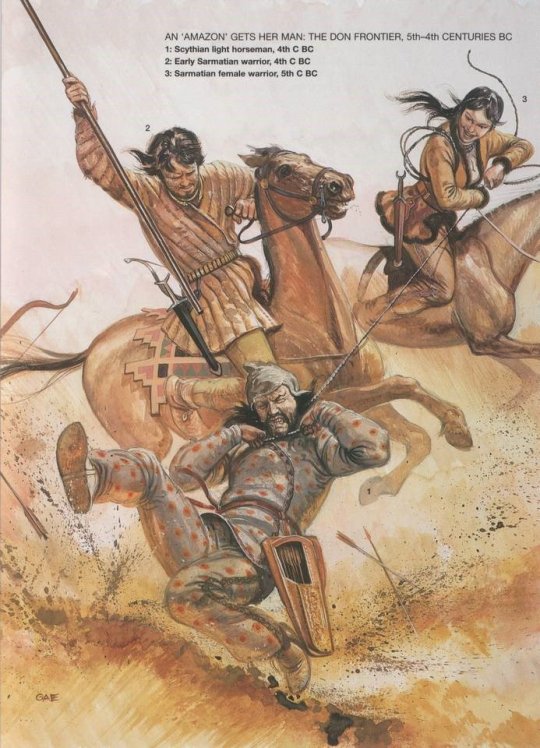
An Amazon gets her man on the Don frontier by Gerry Embleton 2002
"Like most nomads in contact with cattle and wild horses, the Sarmatians employed the lasso, and Sarmatian women were said to have been especially adept in its use. Pomponius Mela (1.21.5) states that Sarmatians tossed the lasso over an enemy's neck to pull him from his horse. Pausanias (1.21.7) describes another technique: 'They throw ropes around any enemies they meet, and then wheel their horses to trip them in the tangle of the rope.' The most famous use of the lasso occurred during the Alan incursion into Parthia in c.AD 73, when the Armenian king Tiridates was caught by a lasso, but managed to cut it with his sword before it tightened around his neck (Josephus, Bell. Jud. 7.7.4).
For several centuries the Don River marked the boundary between Scythian and Sarmatian territories. During the 4th century BC the Sarmatians began to infiltrate across the river, and it is from this period that Greek historians began spinning tales of Amazons, based on the fact that Sarmatian women apparently took part in warfare. Sarmatian girls were supposedly forbidden to marry until they had killed an enemy (Hippocrates, Peri Aeron 17) - or, perhaps more realistically, 'encountered an enemy in combat' (Pomponius Mela, 3.4)."
-The Sarmatians 600 BC-AD 450. R. Brzezinski & M. Mielczarek & G. Embleton. Osprey Publishing.
#sarmatian#scythian#amazons#history#ancient history#literature#classical literature#book art#book illustration#art#pagan
46 notes
·
View notes
Text
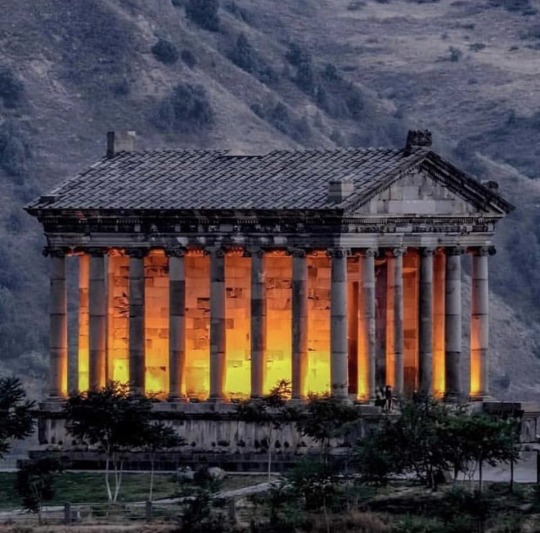
The Temple of Garni, Kotayk Province, Armenia
Likely dedicated to the sun god Mihr by Tiridates I in 77 AD, ten years after having been crowned king by Emperor Nero in Rome, this structure, crafted distinctly in the ionic order out of local basalt, is, for reasons still unknown, the only one of its kind to have survived the persecution of pagans and the destruction of their monuments during Armenia’s conversion to Christianity in the 4th century AD. Variously refitted throughout the Middle Ages as a royal summer home and perhaps even as a mosque for a time, it was eventually toppled in a devastating earthquake in 1679 and laid in ruins until 1975, when a decades-long effort by architectural historians seeking to reconstruct the building using almost entirely original stones finally came to fruition, producing the temple which stands at the site today.
74 notes
·
View notes
Text
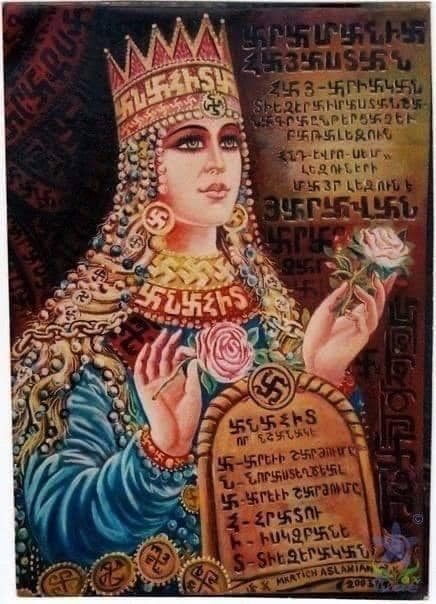
Anahit, Armenian goddess of fertility, healing, wisdom and water. Painting by Mkrtich Aslanian.
According to Strabo, the "Armenians shared in the religion of the Perses and the Medes and particularly honored Anaitis". The kings of Armenia were "steadfast supporters of the cult" and Tiridates III, "prayed officially to the triad Aramazd-Anahit-Vahagn but is said to have shown a special devotion to 'the great lady Anahit, ... the benefactress of the whole human race, mother of all knowledge, daughter of the great Aramazd.”
2 notes
·
View notes
Text
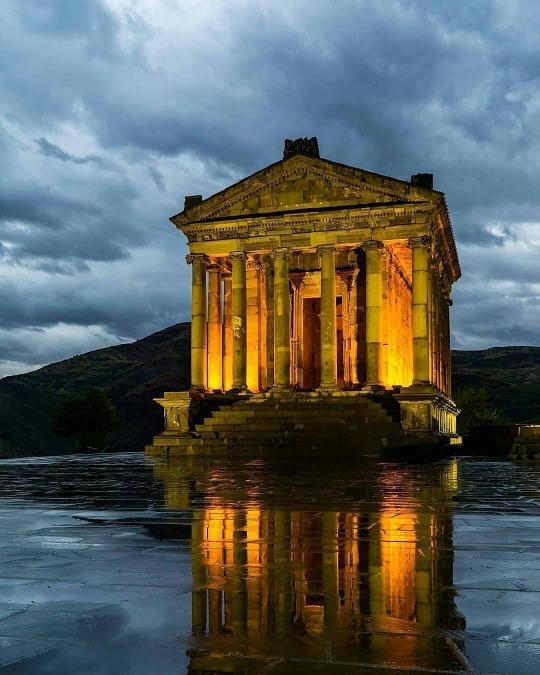
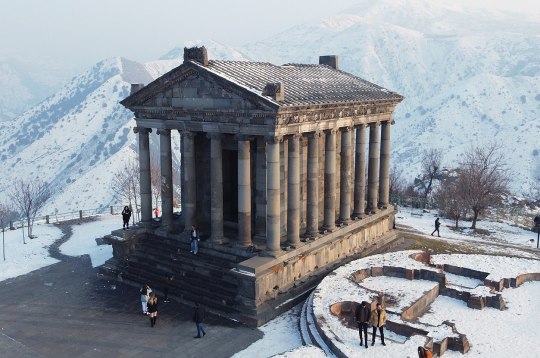
The Temple of Garni (Armenia) is the only standing Greco-Roman colonnaded building in Armenia and the former Soviet Union. Built in the Ionic order, it is located in the village of Garni, in central Armenia, around 30 km (19 mi) east of Yerevan. It is the best-known structure and symbol of pre-Christian Armenia.
The structure was probably built by king Tiridates I in the first century AD as a temple to the sun god Mihr. After Armenia's conversion to Christianity in the early fourth century, it was converted into a royal summer house of Khosrovidukht, the sister of Tiridates III. According to some scholars it was not a temple but a tomb and thus survived the destruction of paganstructures. It collapsed in a 1679 earthquake. Renewed interest in the 19th century led to excavations at the site in early and mid-20th century, and its eventual reconstruction between 1969 and 1975, using the anastylosis method. It is one of the main tourist attractions in Armenia and the central shrine of Hetanism (Armenian neopaganism).
5 notes
·
View notes
Text
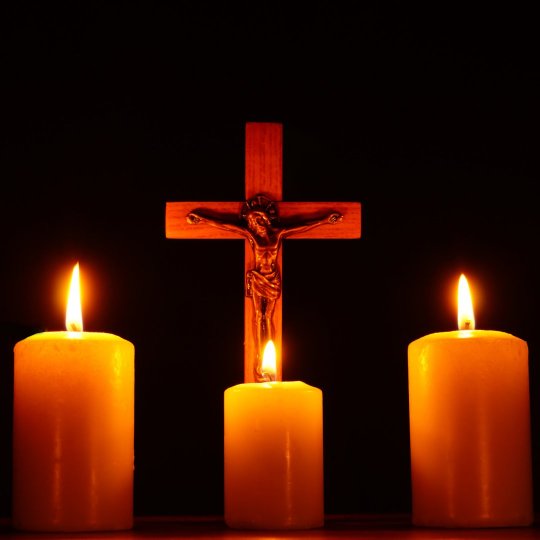
SAINTS AND MARTYRS for September 29
St. Theodota, Roman Catholic Martyr and penitent, she was converted and refused to obey the decree of the local prefect for all citizens of Philipopolis, Thrace (modern southeast Balkans), to participate in the festival of Apollo. Hundreds of Christians followed her lead, and she was arrested and put to torture, she was finally stoned to death. Feastday Sept 29
St. Rhipsime, Roman Catholic Virgin martyr who was put to death with a group of fellow virgins in Armenia. Brought before King Tiridates. Rhipsime refused the royal favors and was put to death by being roasted alive. Gaiana and all of the other maidens except one, called Christiana, were massacred by Armenian soldiers. Christiana later became a missionary in Georgia. Feastday Sept 29
Bl. Miguel de Aozaraza Roman Catholic Dominican priest. and a Martyr of Japan. Feastday Sept 29
B. NICOLA OF FORCA PALENA, JEROLAMIN
Feast of Saints Michael, Gabriel, and Raphael, archangels
Bl. Richard Rolle de Hampole, 1349 A.D. English mystic and hermit. Born at Thornton, Yorkshire, England, circa 1300, he was educated at Oxford and in Paris from 1320-1326, before entering into the life of a hermit on the estate of a friend, John Dalton of Pickering in 1326. After several years of intense contemplation, he took to wandering across England, finally settling down at Hampole where he assisted the spiritual development of the nuns in a nearby Cistercian community. He died there on September 29. Richard was very well known and his writings widely read during the fourteenth and fifteenth centuries. He was one of the first religious writers to use the vernacular. A cult developed to promote his cause after miracles were reported at his tomb, although the cause was never officially pursued. His works include letters, scriptural commentaries, and treatises on spiritual perfection. Perhaps his best known writing was De Incendio Amoris. He also wrote a poem, Pricke of Conscience.
0 notes
Text
Explore historic sites in Armenia
Armenia is a country rich in history and culture, with a long and fascinating past. It is home to numerous historic sites that date back thousands of years. Some of the most notable historic sites in Armenia include:
Garni Temple: Located near the village of Garni, this well-preserved Hellenistic temple dates back to the 1st century AD. It was built by King Tiridates I and is dedicated to the sun god Mihr. The temple stands as a unique example of ancient Greek-style architecture in Armenia.
Geghard Monastery: A UNESCO World Heritage Site, Geghard Monastery is a complex of churches and cave dwellings dating back to the 4th century AD. The monastery is partly carved out of a rock cliff, making it a remarkable architectural feat.
Echmiadzin Cathedral: Also known as the Mother Church of Armenia, Echmiadzin Cathedral is one of the oldest churches in the world, dating back to the early 4th century AD. It is the center of the Armenian Apostolic Church and holds great religious significance for Armenians.
Khor Virap: Situated near the Turkish border, Khor Virap is an ancient monastery that played a vital role in Armenian history. It is where Saint Gregory the Illuminator was imprisoned before converting King Tiridates III to Christianity in the early 4th century AD.
Zvartnots Cathedral: A UNESCO World Heritage Site, Zvartnots Cathedral was a magnificent architectural wonder of the 7th century AD. The cathedral was destroyed by an earthquake but has been partially reconstructed, showcasing its former grandeur.
Noravank Monastery: Located in a narrow gorge, Noravank Monastery is renowned for its stunning red cliffs and intricate medieval architecture. It was the residence of the Orbelyan princes and flourished in the 13th-14th centuries.
Amberd Fortress: Situated on the slopes of Mount Aragats, Amberd is a medieval fortress complex that dates back to the 7th century AD. It served as a significant military stronghold during various periods in Armenian history.
Gyumri Old Town: Gyumri is Armenia's second-largest city and boasts a well-preserved old town with charming 19th-century architecture. Despite the devastating earthquake in 1988, many historic buildings have been restored, offering a glimpse into the country's past.
These are just a few examples of the many historic sites in Armenia that can be explored. The country's rich history and archaeological heritage make it a captivating destination for history enthusiasts and travelers alike.
Starling Travel Club offers the best historic sites in Armenia. Don't hesitate to choose our unique packages and enjoy Armenia with us.
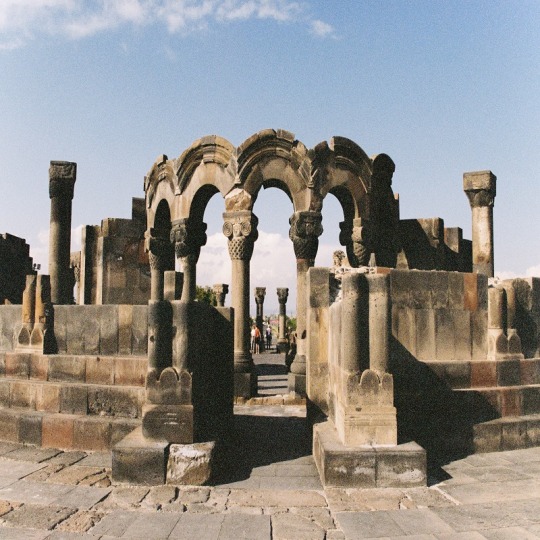
0 notes
Photo

A blessing to serve today in the city of Gyumri where 7 churches came together to be trained in evangelism. Gyumri is the second largest city in Armenia, and the home of GCS Armenia, which is headed up by Pastor Srap Sargsyan. Few nations have histories as ancient, complex and laced with tragedy as Armenia, and even fewer have a culture that is as rich and resilient. Armenia has a striking history of Christianity, because soon after many Christians were martyred for their faith, Armenia became the world’s first officially Christian nation in 301 A.D. under King Tiridates – who was converted under the witness of St. Gregory the Illuminator. Please continue to pray for our time here and for GCS Armenia’s ministry in this region. Jesus is raising up His church on this continent and it's encouraging to witness. #GCSArmenia #GCSUK #GCSPRAYER https://www.instagram.com/p/CklJspBoSQ3/?igshid=NGJjMDIxMWI=
0 notes
Photo
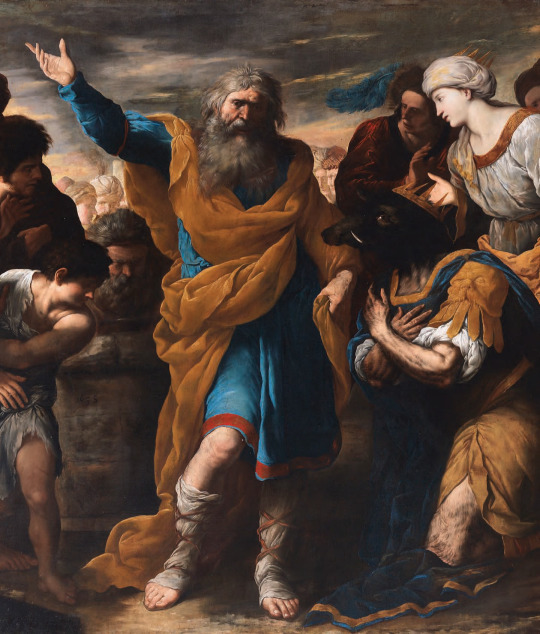

Francesco Fracanzano (Italian, 1612-1656) - Il re Tiridate implora san Gregorio perché gli vengano restituite sembianze umane (detail) [King Tiridates begs St. Gregory for the restoration of his human appearance], between 1635 and 1637. Church of San Gregorio Armeno, Naples
“At that time, Armenia was ruled by Tiridates III, son of the late King Khosrov II. Influenced partly by the fact that Gregory was the son of his father's enemy, he ordered Gregory imprisoned for twelve (some sources indicate fourteen) years in a pit on the Ararat Plain under the present day church of Khor Virap located near the historical city Artashat in Armenia. Gregory was eventually called forth from his pit in c. 297 to restore to sanity Tiridates III, who had lost his reason after he was betrayed by Roman emperor Diocletian. Diocletian invaded vast amounts of territory of western provinces of Greater Armenia, that became protectorates of Rome.
In 301 Gregory baptized Tiridates III along with members of the royal court and upper class as Christians. Tiridates III issued a decree by which he granted Gregory full rights to begin carrying out the conversion of the entire nation to the Christian faith. The same year Armenia became the first country to adopt Christianity as its state religion.” (en.wikipedia)
#painting#art#art history#art detail#baroque#baroque art#baroque painting#francesco fracanzano#king tiridates#st. gregory#naples#chiesa di san gregorio armeno#history of art#armenia
47 notes
·
View notes
Text



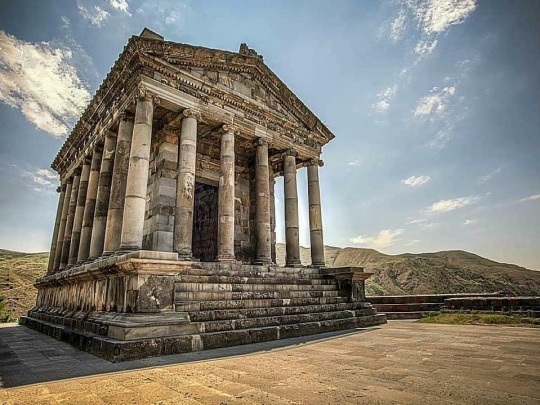



Garni Temple, Armenia. Its exact date of construction is unknown, around 77 AD, during the reign of King Tiridates I, being dedicated to Mihr, the solar god of the Armenian pantheon assimilable to the Roman god Helios.
329 notes
·
View notes
Photo

Temple of Garni is a classical Hellenistic temple in Garni, Armenia. It is perhaps the best-known structure and symbol of pre-Christian Armenia. It was probably built by king Tiridates I in the 1st century AD, as a temple to the sun god Mihr.
8 notes
·
View notes
Text
A Royal Duty
@william-t-sickofyourshit
The two kingdoms had been at war for years, maybe even centuries - one could never know how long; even the oldest chronicles had not mentioned the beginning of the war that had claimed the life of millions of beings - warriors, civilians, men, women, children - everyone.
Two kingdoms, one completely different than the other - a great ocean between them, creating a border not only between the lands, but also between the mindsets for their people.
King Cedric, the ruler of the Kingdom of Gareal, was an old man. His wife had died many years ago, and he decided not to remarry, to his advisors’ and subjects’ despair. For he only had one daughter - a woman, and therefore a person incapable of ruling independently. However, King Cedric did listen to his advisors in one aspect, and decided to use his daughter in a clearly political way.
That was what princesses were for, after all.
All the arrangements had therefore been finished, and princess Mei-Rin boarded a ship that would take her to the Empire of Tirid, a place where her soon-to-be husband awaited her.
The sickness she felt during the cruise had nothing to do with the fact she was on the sea - although she had been prepared for it all this time, she was terrified at the thought of being a wife of a villain. And what if instead of warm welcome, she would be greeted with an assault...?
She was as if in a trance when she was led into the castle where she knew she would have to life her life from now on.
181 notes
·
View notes
Text
Saints&Reading: Wed., Oct. 13, 2021
September 30_October 13
THE PRIESTMARTYR GREGORY, ENLIGHTENER OF GREAT ARMENIA (335)

The Hieromartyr Gregory, Enlightener of Greater Armenia, was born in the year 257. He was descended from a line of Parthian Arsakid kings. Anak, the father of Saint Gregory, was a Parthian by birth. In his quest for the Armenian throne, Anak and his brother attacked their kinsman, King Kursar with their swords, leaving him mortally wounded. The King's servants found him still alive, and he was able to tell them what had happened. Before he expired, the King ordered the execution of Anak, his brother, and also their wives and children. The murderers were caught by a river, where they were slain and their bodies were thrown into the water.
One of Anak's relatives saved Gregory and his brother, who were infants, and hid them in his home. There was a revolt in Armenia, and King Artasirus of Persia was able to conquer Armenia and bring it under his rule. As for Arak's sons, one was taken to Persia, and Gregory was sent to the Roman Empire.
When he reached adulthood, Gregory lived in Caesarea in Cappadocia, where he was converted to the Christian Faith. Gregory married, and had two sons, but soon was left a widower. Gregory raised his sons in piety. One of them, Orthanes, later became a priest, and the other, Arostanes, was tonsured as a monk and went into the wilderness to live in solitude.
In order to atone for the sin of his father, who had murdered the father of Tiridates, Gregory entered into the latter's service, and was a faithful servant to him. Tiridates, who was serving in the Roman army, loved Gregory like a friend, but when he learned that Gregory was a Christian, he became angry. Saint Gregory, however, ignored his master's unjust wrath.
When the Goths attacked the Roman Empire, the Prince of the Goths challenged the Emperor to single combat. The Emperor was afraid to fight the Prince, so he had Tiridates put on his armor and take his place. Tiridates defeated his adversary without using his sword, and led him as a captive to the Emperor. Then the entire Gothic army was defeated. In gratitude, the Emperor made Tiridates King of Armenia. When Tiridates offered sacrifice to his "gods" for his new position, he wanted Gregory to sacrifice with him. Gregory refused, and so Tiridates ordered that he be tortured.
The Saint was suspended head downward, with a stone about his neck, and for several days they choked him with a foul-smelling smoke, they beat and ridiculed him, and forced him to walk in iron sandals inset with nails.
During these torments, Saint Gregory sang Psalms. In prison the Lord healed all his wounds. When Gregory stood before the King cheerful and unharmed, he was astonished and ordered that the torments be repeated. Saint Gregory endured them, not wavering, with his former determination and bearing. They then poured hot tin over him and threw him into a pit filled with snakes, scorpions, and other poisonous creatures. The Lord, however, spared His chosen one, and he was left unharmed.
Some pious women kept him alive for fourteen years by feeding him with bread, secretly lowering it into the pit. A holy angel appeared to the martyr, strengthening and encouraging him. During this time King Tiridates killed the holy virgin Saint Ripsimia (Ριψιμία, or Ριψίμη), the Eldress Gaianḗ (Γαϊανή), and 32 other Virgin Martyrs (some sources say 35) from Asia Minor. Tiridates, who seemed to have lost his mind after this, recovered six days later. Then the wrath of God struck King Tiridates, his associates, and the soldiers who had participated in the execution of the virgins. Beset by demons, their appearance resembled wild boars, as once happened to Nebuchadnezzar (Daniel 4:30). Running through forests and fields, they tore their clothes and devoured their own flesh.
Saint Gregory was taken from the pit, and then he was washed, dressed in clean clothes, and fed. Then he was led to the King. Everyone bowed before him, begging him to ask God to heal the King as well as the others responsible for killing the Holy Virgin Martyrs. First, the Saint asked about their relics, which remained unburied for nine days. Saint Gregory buried the bodies, and then began preaching to the people, urging them to turn away from the darkness of idolatry and toward Christ. The people came to believe in Christ, and wanted to build a large church. When it was completed, Saint Gregory had the relics of the holy nuns brought into it. Then he led King Tiridates to the church before the bodies of the Saints whom he had slain, so that they might pray to Christ for him. He repented, and at once his face was restored to its original appearance once more.
Soon all of Armenia was converted to Christ. The temples of the idols were destroyed, and churches for the worship of the only true God were built. Saint Gregory ordained priests, established schools, founded monasteries, and provided for the good order of the Church.
After this, Saint Gregory went into the wilderness, where he ended his earthly life in a manner pleasing to the Lord. His son Aristanes was made a bishop in Cappadocia, and was one of the 318 Holy Fathers of. the Council of Nicea.
SAINT MICHAEL, THE FIRST METROPOLITAN OF KIEV (992)

Saint Michael the first Metropolitan of Kiev, according to the Joakimov chronicle, was a Syrian by birth, but according to other chronicles, he was a Bulgarian or Serb. In the year 989, he arrived at Korsun with other clergy for holy Prince Vladimir (July 15), not long after Vladimir’s Baptism (988).
As first metropolitan of the Russian Church his service was difficult, but grace-filled. He zealously made the rounds of the newly-enlightened Russian Land, preaching the Holy Gospel, baptizing and teaching the newly-illumined people, founding the first churches and religious schools.
In Rostov he established the first wooden church in honor of the Dormition of the Most Holy Theotokos and installed Theodore the Greek there as bishop. Saint Michael was a wise and gentle, but also strict hierarch. The Russian Church has preserved the memory of the saint’s praiseworthy deeds. In the Synodikon of the Novgorod and Kiev Sophia cathedrals he is rightfully called the initiator.
Saint Michael died in the year 992 and was buried in the Desyatin-Tithe church of the Most Holy Theotokos in Kiev. In about the year 1103, under the Igumen Saint Theoctistus (afterwards Bishop of Chernigov, August 5), his relics were transferred to the Antoniev Cave, and on October 1, 1730 into the Great Church of the Caves. Thus his memory was celebrated on September 30, and also July 15, the day of his repose.
Formerly, his memory was celebrated on September 2, along with Saints Anthony and Theodosius of the Caves. There is a trace of this earlier celebration in the service to Saint Michael. In the second verse of the “Praises” we sing: “Having begun the new year, we offer you our first songs, O blessed one, for you were the beginning of the hierarchy in the Russian land.”
Source: Orthodox Church of America (OCA)

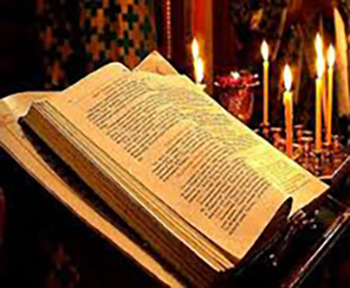
LUKE 5:33-39
33 Then they said to Him, "Why do the disciples of John fast often and make prayers, and likewise those of the Pharisees, but Yours eat and drink?" 34 And He said to them, "Can you make the friends of the bridegroom fast while the bridegroom is with them? 35 But the days will come when the bridegroom will be taken away from them; then they will fast in those days. 36 Then He spoke a parable to them: "No one puts a piece from a new garment on an old one; otherwise the new makes a tear, and also the piece that was taken out of the new does not match the old. 37 And no one puts new wine into old wineskins; or else the new wine will burst the wineskins and be spilled, and the wineskins will be ruined. 38 But new wine must be put into new wineskins, and both are preserved. 39 And no one, having drunk old wine, immediately desires new; for he says, 'The old is better.'
EPHESIANS 4:14-19
14 that we should no longer be children, tossed to and fro and carried about with every wind of doctrine, by the trickery of men, in the cunning craftiness of deceitful plotting, 15 but, speaking the truth in love, may grow up in all things into Him who is the head-Christ-16 from whom the whole body, joined and knit together by what every joint supplies, according to the effective working by which every part does its share, causes growth of the body for the edifying of itself in love. 17 This I say, therefore, and testify in the Lord, that you should no longer walk as the rest of the Gentiles walk, in the futility of their mind,18 having their understanding darkened, being alienated from the life of God, because of the ignorance that is in them, because of the blindness of their heart; 19 who, being past feeling, have given themselves over to lewdness, to work all uncleanness with greediness.
1 note
·
View note
Photo

Temple of Garni (Armenia) is a former pagan temple and was built by king Tiridates I in the 1st century AD dedicated to the sun god Mihr. via /r/ArchitecturePorn https://www.reddit.com/r/ArchitecturePorn/comments/kqkjgg/temple_of_garni_armenia_is_a_former_pagan_temple/?utm_source=ifttt
6 notes
·
View notes
Photo
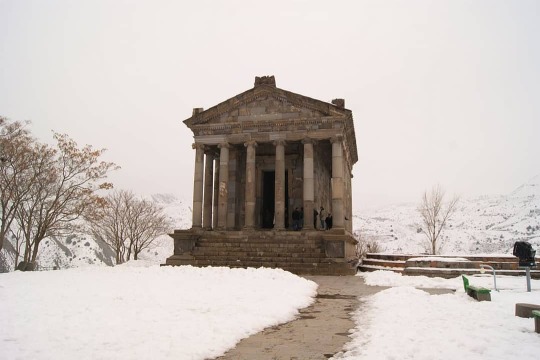
Temple of Garni, #Armenia The structure was probably built by king Tiridates I in the first century AD as a temple to the sun god Mihir. https://www.instagram.com/p/CAQPeMCFiRC/?igshid=8egpnj48ab5f
47 notes
·
View notes